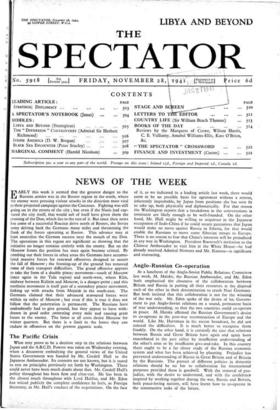NEWS OF THE WEEK
EARLY this week it seemed that the greatest danger to the Russian armies was in the Rostov region in the south, where the enemy were pressing violent attacks in the direction most vital to their projected campaign against the Caucasus. Fighting was still going on in the streets of the city ; but even if the Nazis had cap- tured the city itself, that would not of itself have given them the crossing of the Don, which lies to the east of it. But since then news has come of a successful Russian drive north of Rostov, the Soviet army driving back the Germans many miles and threatening the flank of the forces operating at Rostov. This advance may at least neutralise the German success near the mouth of the Don. The operations in this region are significant as showing that the initiative no longer remains entirely with the enemy. But on the Moscow fronts the position has once again become critical. By combing out their forces in othek areas the Germans have accumu- lated massive forces for renewed offensives designed to secure the fall of Moscow ; the freezing-up of the ground has removed some of their transport difficulties. The grand offensive appears to take the form of a double pincer movement—south of Moscow (once again in the Tula region) and north-west, where Klin, midway between Kalinin and Moscow, is a danger-point ; and this northern movement is itself part of a secondary pincer movement, linking up with attacks from Mojaisk in the south-east. The Germans claimed that their advanced armoured forces were within 19 miles of Moscow ; but even if this is true it does not follow that the penetration is permanent. The Russians have undoubtedly had to give ground, but they appear to have with- drawn in good order contesting every mile and causing great losses to the enemy. The latter at all costs desire Moscow for winter quarters. But there is a limit to the losses they can endure in offensives on the present gigantic scale.


























